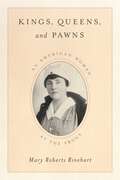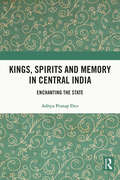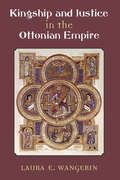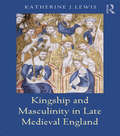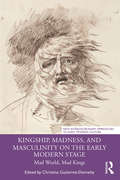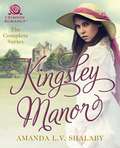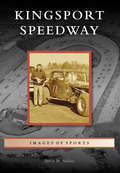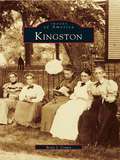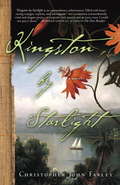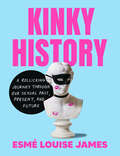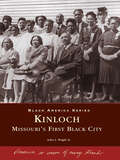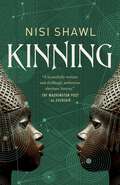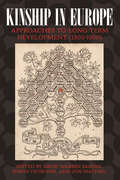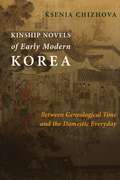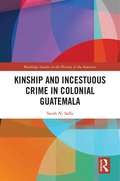- Table View
- List View
Kings, Queens, Bones and Bastards: Who's Who in the English Monarchy From Egbert to Elizabeth II
by David HilliamWho invented the 'House of Windsor' as a royal name? Who founded Westminster Abbey? Which king had twenty-one illegitimate children? David Hilliam answers all of these questions and more. Here is a continuous history of the English monarchy, showing how the nine dynasties rose and fell. The book describes the most memorable features of the life and times of each king and queen - from Egbert, crowned in 802 and considered the first king of England, to Queen Elizabeth II - as well as recording the extraordinary lives of their queens, consorts, mistresses and bastard children. It also tells the story of the Saxons, describes what has happened to the monarchs' mortal remains, and relates many lively incidents of royal history that rarely appear in the text books. Read of the saintly Edward the Confessor, who is believed to have refused to consummate his marriage; of teh rumbustious Henry VIII, given to beheading those who displeased him; of the 'little gentleman in black velvet', who caused the death of William III; and of Queen Victoria's strangest servant, the 'Munshi', Queen Emma, who endured a trial by ordeal; and Anne Boleyn, widely suspected of being a witch. A complete list of the monarchs' reigns and a genealogical table showing the royal descent down thirty-seven generations from Egbert to Elizabeth II adds to the volume's reference value.
Kings, Queens, and Pawns: An American Woman at the Front
by Mary Roberts RinehartIn 1914, journalist and mystery writer Mary Roberts Rinehart traveled to Europe alone to cover World War I for the Saturday EveningPost. This collection of her writings encompasses her observations on her travels—from being received by King Albert in Belgium and recording his first authorized statement on the war, to meeting Winston Churchill, to traveling to the English and French front lines as the first correspondent permitted there. Rinehart&’s book was a humanitarian plea to Americans to join the war effort three years before the American Expeditionary Force set sail for Europe, an unpopular view vindicated by subsequent events.
Kings, Spirits and Memory in Central India: Enchanting the State
by Aditya Pratap DeoPart anthropological history and part memoir, this book is a unique study of the polity of the colonial-princely state of Kanker in central India. The author, a scion of the erstwhile ruling family of Kanker, delves into the oral accounts given in the ancestral deity practices of the mixed tribe-caste communities of the region to highlight popular narratives of its historical polity. As he struggles with his own dilemmas as ethnographer-king, what comes into view is a polity where the princely state is drawn out amidst a terrain of gods and spirits as much as that of law courts and magistrates, and political power is divided, contested and shared between the raja/state and the people. This study constitutes not only an intervention in the larger debate on the relationship between state formations and tribal peoples, but also on the very nature of history as a knowledge practice, especially the understandings of power, authority and sovereignty in it. Combining intensive ethnography, complementary archival work and crucial theoretical questions engaging social scientists worldwide, the author charts an unusual explanatory path that can allow us to meaningfully understand societies/peoples that have historically been marginalized and seen as different. This book will be of interest to students and researchers of history, anthropology, politics, religion, tribal society and Modern South Asia.
Kings, Usurpers, and Concubines in the 'Chronicles of the Kings of Man and the Isles'
by R. Andrew McDonaldThis Palgrave Pivot explores the representation of sea kings, sinners, and saints in the mid-thirteenth century Chronicles of the Kings of Man and the Isles, the single most important text for the history of the kingdoms of Man and the Isles, c.1066-1300. The focus of the Chronicles on the power struggles, plots and intrigues within the ruling dynasties of Man and the Isles offers an impressive array of heroes and villains. The depiction of the activities of heroic sea kings like Godred Crovan, tyrannical usurpers like Harald son of Godred Don, and their concubines and wives, as well as local heroes like Saint Maughold, raises important questions concerning the dynamic interactions of power, gender and historical writing in the medieval Kingdoms of Man and the Isles, and provide new insights into the significance of the text that is our most important source of information on these ‘Forgotten Kingdoms’ of the medieval British Isles.
Kingship and Consent in Anglo-Saxon England, 871-978
by Levi RoachThis engaging new study focuses on the role of assemblies in later Anglo-Saxon politics, challenging and nuancing existing models of the late Anglo-Saxon state. Its ten chapters investigate both traditional constitutional aspects of assemblies - who attended these events, where and when they met, and what business they conducted - and the symbolic and representational nature of these gatherings. Levi Roach takes into account important recent work on continental rulership, and argues that assemblies were not a check on kingship in these years, but rather an essential feature of it. In particular, the author highlights the role of symbolic communication at assemblies, arguing that ritual and demonstration were as important in English politics as they were elsewhere in Europe. Far from being exceptional, the methods of rulership employed by English kings look very much like those witnessed elsewhere on the continent, where assemblies and ritual formed an essential part of the political order.
Kingship and Justice in the Ottonian Empire
by Laura WangerinLaura E. Wangerin challenges traditional views of the Ottonian Empire’s rulership. Drawing from a broad array of sources including royal and imperial diplomas, manuscript illuminations, and histories, Ottonian kingship and the administration of justice are investigated using traditional historical and comparative methodologies as well as through the application of innovative approaches such as modern systems theories. This study suggests that distinctive elements of the Ottonians’ governing apparatus, such as its decentralized structure, emphasis on the royal iter, and delegation of authority, were essential features of a highly developed political system. Kingship and Justice in the Ottonian Empire provides a welcome addition to English-language scholarship on the Ottonians, as well as to scholarship dealing with rulership and medieval legal studies. Scholars have recognized the importance of ritual and symbolic behaviors in the Ottonian political sphere, while puzzling over the apparent lack of administrative organization, a contradiction between what we know about the Ottonians as successful rulers and their traditional characterization as rulers of a disorganized polity. Trying to account for the apparent disparity between their political and military achievements, cultural and artistic efflorescence, and relative dynastic stability, which seemingly accompanied a disinterest in writing law or creating a centralized hierarchical administration, is a tension that persists in the scholarship. This book argues that far from being accidental successes or employing primitive methods of governance, the Ottonians were shrewd rulers and administrators who exploited traditional methods of conflict resolution and delegated jurisdictional authority to keep control over their vast empire. Thus, one of the important things that this book aims to accomplish is to challenge our preconceived notions of what successful government looks like.
Kingship and Masculinity in Late Medieval England
by Katherine LewisKingship and Masculinity in Late Medieval England explores the dynamic between kingship and masculinity in fifteenth century England, with a particular focus on Henry V and Henry VI. The role of gender in the rhetoric and practice of medieval kingship is still largely unexplored by medieval historians. Discourses of masculinity informed much of the contemporary comment on fifteenth century kings, for a variety of purposes: to praise and eulogise but also to explain shortcomings and provide justification for deposition. Katherine J. Lewis examines discourses of masculinity in relation to contemporary understandings of the nature and acquisition of manhood in the period and considers the extent to which judgements of a king’s performance were informed by his ability to embody the right balance of manly qualities. This book’s primary concern is with how these two kings were presented, represented and perceived by those around them, but it also asks how far Henry V and Henry VI can be said to have understood the importance of personifying a particular brand of masculinity in their performance of kingship and of meeting the expectations of their subjects in this respect. It explores the extent to which their established reputations as inherently ‘manly’ and ‘unmanly’ kings were the product of their handling of political circumstances, but owed something to factors beyond their immediate control as well. Consideration is also given to Margaret of Anjou’s manipulation of ideologies of kingship and manhood in response to her husband’s incapacity, and the ramifications of this for perceptions of the relational gender identities which she and Henry VI embodied together. Kingship and Masculinity in Late Medieval England is an essential resource for students of gender and medieval history.
Kingship and Polity on the Himalayan Borderland: Rajput Identity during the Early Colonial Encounter (Asian Borderlands)
by Arik MoranKingship and Polity on the Himalayan Borderland explores the modern transformation of state and society in the Indian Himalaya. Centred on three Rajput led-kingdoms during the transition to British rule (c. 1790-1840) and their interconnected histories, it demonstrates how border making practices engendered a modern reading of 'tradition' that informs communal identities to this day. Countering the common depiction of these states as all-male, caste-exclusive entities, it reveals the strong familial base of Rajput polity, wherein women — and regent queens in particular — played a key role alongside numerous non-Rajput groups. Drawing on rich archival records, rarely examined local histories, and nearly two decades of ethnographic research, it offers an alternative to the popular and scholarly discourses that developed with the rise of colonial knowledge. The analysis exposes the cardinal contribution of borderland spaces to the fabrication of group identities. This book will interest historians and anthropologists of South Asia and of the Himalaya, as well as scholars working on postcolonialism, gender, and historiography.
Kingship, Conquest, and Patria (Studies in Medieval History and Culture #35)
by Kristen Lee OverFirst Published in 2005. Routledge is an imprint of Taylor & Francis, an informa company.
Kingship, Madness, and Masculinity on the Early Modern Stage: Mad World, Mad Kings (New Interdisciplinary Approaches to Early Modern Culture)
by Christina Gutierrez-DennehyKingship, Madness, and Masculinity examines representations of mad kings in early modern English theatrical texts and performance practices. Although there have been numerous volumes examining the medical and social dimensions of mental illness in the early modern period, and a few that have examined stage representations of such conditions, this volume is unique in its focus on the relationships between madness, kingship, and the anxiety of lost or fragile masculinity. The chapters uncover how, as the early modern understanding of mental illness refocused on human, rather than supernatural, causes, public stages became important arenas for playwrights, actors, and audiences to explore expressions of madness and to practice diagnoses. Throughout the volume, the authors engage with the field of disability studies to show how disability and mental health were portrayed on stage and what those representations reveal about the period and the people who lived in it. Altogether, the essays question what happens when theatrical expressions of madness are mapped onto the bodies of actors playing kings, and how the threat of diminished masculinity affects representations of power. This volume is the ideal resource for students and scholars interested in the history of kingship, gender, and politics in early modern drama.
Kingsley Manor: The Complete Series
by Shalaby, Amanda L. V.Gothic fans will enjoy this dark Regency duology featuring love lost and found at stately Kingsley Manor.Rhianna: Alone after the death of her parents, nineteen-year-old Rhianna Braden must give up her life and beaus to move to Kingsley Manor. Her uncommon beauty captures the attention of the dashing Lord Thayne Brighton, but Rhianna is certain, despite their mutual attraction, that he will never choose her over his wealthy intended. Meanwhile, Lady Lydia Kingsley suspects her husband Guilford’s attention to the new family member under their roof has led to an affair between them. Caught in the web of desire and lies, Rhianna finds her own life in danger when the truth inevitably comes to light. After all, family secrets are not meant to be kept. Audra: Wealthy heiress Audra Kingsley agrees to go along with her father’s insistence on a London season, even though she’s always been promised to marry her neighbor and childhood sweetheart, Lord Crispin Brighton. She heads to London with her patroness, the eccentric Lady Sutherland, who is determined to show the young debutante that she has more options than a second son. Unfortunately, Audra is also the object of a secret admirer’s obsession who plans to compromise her into an unwanted marriage. Can a country girl thwart the city Ton to return to her beloved? Sensuality Level: Behind Closed Doors
Kingsnorth Airship Station: In Defence of the Nation
by Tina BilbeKingsnorth Airship Station played a vital role during the First World War, developing airships which successfully protected the fleet from submarine attack. It was the proud boast of the Airship Service that no vessels accompanied by one of their airships were lost to submarine attack. This book tells the story of Kingsnorth, exploring the development of the station, the challenges faced and overcome, the people who contributed to the station’s success and how the station and its legacy have changed the local area. Contemporary accounts and pictures bring this story to life, whether for the local historian, military enthusiast or a relative linked with Kingsnorth.
Kingsport Speedway (Images of Sports)
by David M. McgeeKingsport Speedway has hosted many of racing's greatest drivers, whether its track surface was asphalt, red clay, or brushed concrete. The short track, located in East Tennessee, has undergone dramatic changes since 1965 in attempts to keep pace with an ever-evolving motorsports landscape while entertaining three generations of fans. Hall of Fame members have raced and won at Kingsport Speedway, as did a contingent of regional stars. Today, Kingsport Speedway features weekly programs of NASCAR's Whelen All-American Series, which crowns track, state, regional, and national champions.
Kingston
by Betty J. CotterPerhaps no village in Rhode Island can boast the history of Kingston, or "Little Rest" as it was called. Once a seat of government (its library was one of Rhode Island's five state houses), Kingston has been home to some of the state's most illustrious residents as well as the now sprawling University of Rhode Island. A center of intellectual life long before the university began, Kingston was characterized by social, civic, and dramatic clubs, academies for both men and women, taverns for the weary traveler, and an imposing church atop Kingston Hill whose influence was felt broadly in the village.More than 200 photographs take the reader back tonineteenth-century Kingston, where Stephen Knowles waits atop his carriage to take travelers to Kingston Station, hat maker Cyrus French regales the menfolk in Joe Reynolds's tavern with his expansivestories, and the villagers gather on a summer evening to listen to a musicale on the library's lawn. Within Kingston's pages, the reader can meet people like Solomon Fayerweather, the village blacksmith and church sexton with a unique wisdom about village doings; and Quaker Billy Rose, whose fine weaving work was sought by the likes of Mrs.Theodore Roosevelt. See the familiar, Colonial-style houses that still line Kingstown Road as well as others that have fallen victim to the wrecking ball. Photographs of nearby "Biscuit City" and West Kingston are also included. These photographs, mostly from the collection of the Pettaquamscutt Historical Society, chronicle church, school, and business life in this picturesque village that has played such an important role in Rhode Island's history.
Kingston by Starlight
by Christopher John FarleyIrish-born Anne Bonny is only a teenager when she is left destitute by her mother’s death. Abandoned by her father, she seems destined to be forgotten by the world. But Anne chooses to seek her fortune in the lush tropics of the colonial West Indies, where she passes herself off as a young man named Bonn. She finds work as a ship’s hand, sailing under the command of Calico Jack Rackam, a notorious and charismatic pirate with a bounty on his head. Calico Jack has his heart set on raiding the Madrid Galleon, the richest ship in the Caribbean, which sails from Kingston laden with Cuban gold and Jamaican rum. Bonn is entranced by the sea and by the ship’s violent crew, which includes a mysterious swordfighter named Read, who, it turns out, has a secret life of his own. Calico Jack soon discovers Bonn’s and Read’s true identities, but it is only when the three pirates are captured that their darkest secrets begin to surface. In the shadow of the gallows, a strange twist of fate reveals a shocking betrayal that may save Bonn from death, while permanently changing everything she has known about her past and the world around her. Gorgeously written and full of mystery, intrigue, and startling revelations about gender, race, history, and the human heart, Kingston by Starlight is a once-in-a-lifetime read. From the Trade Paperback edition.
Kinky Gazpacho
by Lori TharpsMagazine writer and editor Lori Tharps was born and raised in the comfortable but mostly White suburbs of Milwaukee, Wisconsin, where she was often the only person of color in her school and neighborhood. At an early age, Lori decided that her destiny would be discovered in Spain. She didn't know anyone from Spain, had never visited the country, and hardly spoke the language. Still, she never faltered in her plans to escape to the Iberian Peninsula. Arriving in the country as an optimistic college student, however, Lori soon discovers Spain's particular attitude toward Blackness. She is chased down the street by the local schoolchildren and pointed at incessantly in public, and her innocent dreams of a place where race doesn't matter are shattered. The story would end there, except Lori meets and marries a Spaniard, and that's when her true Spanish adventure really begins. Against the ancient backdrops of Cádiz and Andalucía, Lori starts the intricate yet amusing journey of rekindling her love affair with Spain and becoming a part of her new Spanish family. From a grandmother who spies on her to a grandfather who warmly welcomes her to town with a slew of racist jokes, the close-knit clan isn't exactly waiting with open arms. Kinky Gazpacho tells the story of the redeeming power of love and finding self in the most unexpected places. At its heart, this is a love story. It is a memoir, a travel essay, and a glimpse into the past and present of Spain. As humorous and entertaining as such favorite travel stories as Under the Tuscan Sun, this book also unveils a unique and untold history of Spain's enduring connection to West Africa. Kinky Gazpacho celebrates the mysticism of travel and the joys of watching two distinct cultures connect and come together.
Kinky History: A Rollicking Journey through Our Sexual Past, Present, and Future
by Esmé Louise JamesA provocative journey through human sexual history, packed with fun factoids and forgotten stories, from the historian and storyteller behind Kinky History, @esme.louisee on TikTokContrary to popular belief, our predecessors had all sorts of obscene hobbies long before Christian Grey hit the scene. In this enlightening romp, learn about the first instances of homosexuality on record from the ancient world and the diverse history of nonbinary gender; encounter a thousand years&’ worth of hilarious and horrifying contraceptive methods; consider the positive and negative effects of the widespread availability of pornography in the digital age—and how our relationship to it changed during the pandemic; take a sneaky riffle through centuries of bedside drawers; and discover the dirty little secrets of luminaries such as Julius Caesar, James Joyce, Albert Einstein, and Virginia Woolf. Esmé Louise James also identifies the key tipping points that directly inform current beliefs around sex to place the past in conversation with the present. By educating ourselves about the weird, wonderful, and varied spectrum of human sexuality and experience, we can normalize and destigmatize sex, write people of marginalized sexual identities back into the pages of history, and build toward a more liberated future.
Kinloch: Missouri's First Black City (Black America Series)
by John A. Wright Sr.Located just outside of St. Louis, Kinloch was once a community locked off from the rest of the area by natural and man-made barriers. In spite of a lack of financial resources, it once provided its residents with a school district, city hall, post office, business district, and recreational facilities. Residents will recognize Dunbar Elementary, the oldest school for blacks in St. Louis County, Holy Angels, the oldest continuing black parish in the St. Louis Archdiocese, as well as former residents Congresswoman Maxine Waters and political activist Dick Gregory. Eventually, due to insufficient revenue, this once thriving community fell into decline, and is now struggling to keep its small town values and ideals alive.
Kinning (Everfair #2)
by Nisi ShawlNamed a Best Fantasy and Sci-Fi Book of The Year by Elle!Kinning, the sequel to Nisi Shawl’s acclaimed debut novel Everfair, continues the stunning alternate history where barkcloth airships soar through the sky, varied peoples build a new society together, and colonies claim their freedom from imperialist tyrants.The Great War is over. Everfair has found peace within its borders. But our heroes’ stories are far from done.Tink and his sister Bee-Lung are traveling the world via aircanoe, spreading the spores of a mysterious empathy-generating fungus. Through these spores, they seek to build bonds between people and help spread revolutionary sentiments of socialism and equality—the very ideals that led to Everfair’s founding.Meanwhile, Everfair’s Princess Mwadi and Prince Ilunga return home from a sojourn in Egypt to vie for their country’s rule following the abdication of their father King Mwenda. But their mother, Queen Josina, manipulates them both from behind the scenes, while also pitting Europe’s influenza-weakened political powers against one another as these countries fight to regain control of their rebellious colonies.Will Everfair continue to serve as a symbol of hope, freedom, and equality to anticolonial movements around the world, or will it fall to forces inside and out?At the Publisher's request, this title is being sold without Digital Rights Management Software (DRM) applied.
Kinross Saga: Trade Winds, Highland Storms, Monsoon Mists
by Christina CourtenayThree intrepid Highlanders pursue love and fortune across the globe in these “majestic” historical romances (Elder Park Book Reviews). Steeped in “fascinating history, with plenty of chemistry and action to go around,” each novel in this saga follows a member of the Kinross clan on a voyage into the heart of the woman he loves (RT Book Reviews). From Scotland to Sweden, China, India, and beyond, these intrepid Highlanders discover that romance is the greatest adventure of all. Trade Winds It is 1732. Former gambler Killian Kinross sails to Sweden in pursuit of an honest trade, only to be propositioned with a marriage of convenience that leads him out to the high seas and into the arms of his true love.Highland Storms It is 1754. Brice Kinross leaves Sweden to reclaim his family’s Highland estate—only to discover a mystery waiting to be solved, and a beautiful housekeeper who just might be the love he was destined for. Monsoon Mists It is 1759. Jamie Kinross leaves Sweden for India to make his fortune in the gem trade. There, he encounters the fiercely independent Zarmina Miller. Both are embroiled in a sinister ransom plot, and soon realize they are also bound together in love . . .
Kinship In Europe
by David Warren Sabean Jon Mathieu Simon TeuscherSince the publication of Philippe Ariès's book, Centuries of Childhood, in the early 1960s, there has been great interest among historians in the history of the family and the household. A central aspect of the debate relates the story of the family to implicit notions of modernization, with the rise of the nuclear family in the West as part of its economic and political success. During the past decade, however, that synthesis has begun to break down. Historians have begun to examine kinship - the way individual families are connected to each other through marriage and descent - finding that during the most dynamic period in European industrial development, class formation, and state reorganization, Europe became a "kinship hot" society. The essays in this volume explore two major transitions in kinship patterns - at the end of the Middle Ages and at the end of the eighteenth century - in an effort to reset the agenda in family history.
Kinship Myth in Ancient Greece
by Lee E. PattersonIn ancient Greece, interstate relations, such as in the formation of alliances, calls for assistance, exchanges of citizenship, and territorial conquest, were often grounded in mythical kinship. In these cases, the common ancestor was most often a legendary figure from whom both communities claimed descent. In this detailed study, Lee E. Patterson elevates the current state of research on kinship myth to a consideration of the role it plays in the construction of political and cultural identity. He draws examples both from the literary and epigraphical records and shows the fundamental difference between the two. He also expands his study into the question of Greek credulity--how much of these founding myths did they actually believe, and how much was just a useful fiction for diplomatic relations? Of central importance is the authority the Greeks gave to myth, whether to elaborate narratives or to a simple acknowledgment of an ancestor. Most Greeks could readily accept ties of interstate kinship even when local origin narratives could not be reconciled smoothly or when myths used to explain the link between communities were only "discovered" upon the actual occasion of diplomacy, because such claims had been given authority in the collective memory of the Greeks.
Kinship Novels of Early Modern Korea: Between Genealogical Time and the Domestic Everyday (Premodern East Asia: New Horizons)
by Ksenia ChizhovaThe lineage novel flourished in Korea from the late seventeenth to the early twentieth century. These vast works unfold genealogically, tracing the lives of several generations. New storylines, often written by different authors, follow the lives of the descendants of the original protagonists, offering encyclopedic accounts of domestic life cycles and relationships. Elite women transcribed these texts—which span tens and even hundreds of volumes—in exquisite vernacular calligraphy and transmitted them through generations in their families.In Kinship Novels of Early Modern Korea, Ksenia Chizhova foregrounds lineage novels and the domestic world in which they were read to recast the social transformations of Chosŏn Korea and the development of early modern Korean literature. She demonstrates women’s centrality to the creation of elite vernacular Korean practices and argues that domestic-focused genres such as lineage novels, commemorative texts, and family tales shed light on the emergence and perpetuation of patrilineal kinship structures. The proliferation of kinship narratives in the Chosŏn period illuminates the changing affective contours of familial bonds and how the domestic space functioned as a site of their everyday experience. Drawing on an archive of women-centered elite vernacular texts, Chizhova uncovers the structures of feelings and conceptions of selfhood beneath official genealogies and legal statutes, revealing that kinship is as much a textual as a social practice. Shedding new light on Korean literary history and questions of Korea’s modernity, this book also offers a broader lens on the global rise of the novel.
Kinship and Incestuous Crime in Colonial Guatemala
by Sarah N. SaffaKinship and Incestuous Crime in Colonial Guatemala examines social relations in colonial Guatemala through the lens of incest. Using a combination of qualitative and quantitative analyses of incest trials from the Spanish secular courts, this study shows that incest codes were not homogenous nor were its various forms equally condemned. Further, incest codes and the criminal process impacted the articulation of kinship and contributed to the racialization of kin behavior. Colonial actors of all sorts were proficient at using these types of distinctions as they negotiated various crises in their lives. The models of relatedness created within incestuous crime ultimately foreshadowed changes in marriage proscriptions and continued racial polarization following independence from Spain. Overall, this study demonstrates how the lens of incest can add further nuance to our understanding of social relations in a given area. Incest codes force latent divisions between kin to the surface and can provide individuals with multiple avenues to creatively manage interpersonal relationships. They also afford a fruitful arena in which to explore social inequalities in society and mechanisms of culture change. This book will appeal to anyone interested in Latin America or engaged in the fields of kinship, gender, or sexuality studies.
Kinship and Marriage Among the Nuer
by E. E. Evans-PritchardSir Edward Evans-Pritchard's classic writings on the Nuer of southern Sudan have made them one of the most famous peoples in ethnographic literature. When the writings were first published half a century ago, they created a new agenda for social anthropology. Kinship and Marriage among the Nuer is the second of his trilogy on the society and culture of this pastoral people. It vividly portrays the experience of growing up in a Nuer community, describing daily life, marriage, sex, death, and birth. It also makes clear the essential difference between the discourse of political association and that of kinship, and shows the part played by the kinship system in Nuer society as a whole. Now published for the first time in paperback, this edition has a substantial introduction by Wendy James in which she assesses the importance of Evans-Pritchard's work and places it in the context of recent developments in social anthropology.

